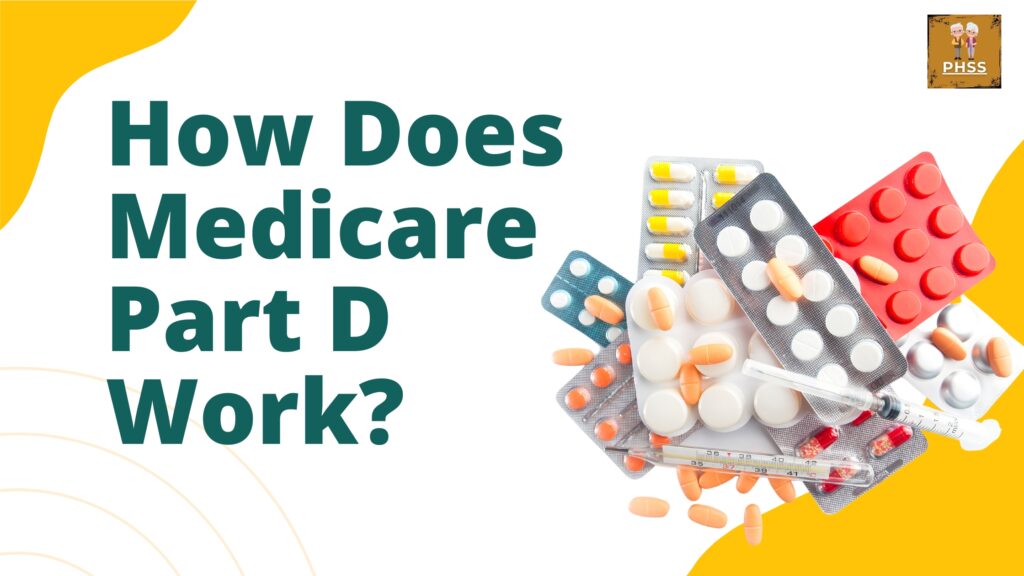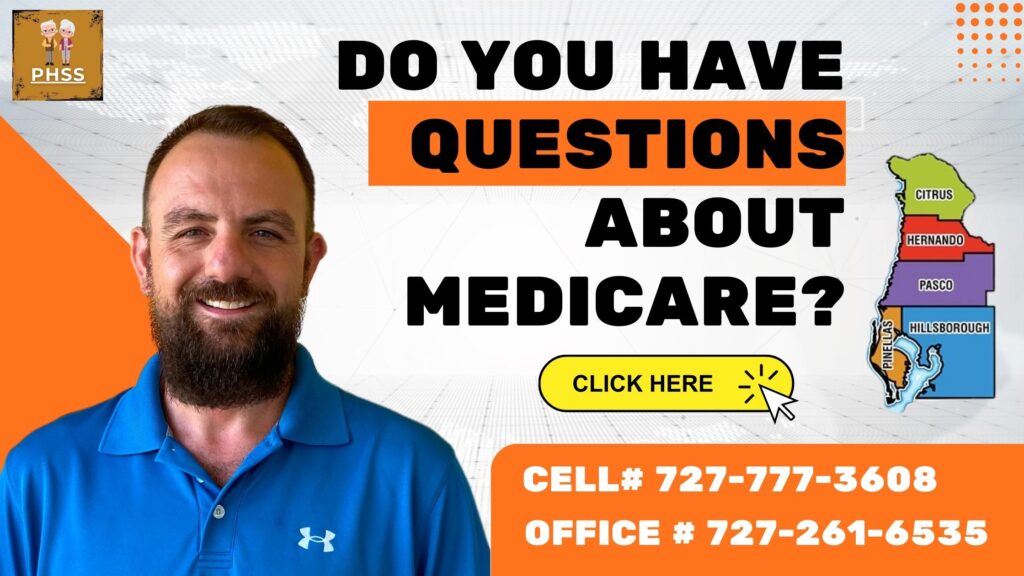How Does Medicare Part D Work?

Everyone knows that prescription drugs can cost a lot of money. If you have a condition that requires you to take some drugs continually, it can really hurt your wallet. If you have Medicare you can buy a Medicare Part D plan to help with those costs. This article ” How does Medicare Part D Work” will explain to you everything you need to know about it.
It is my intention to answer most of your questions in this article, but if I miss something please email me at daniel@pascohernandoseniorservices.org and I will answer your question.
What is Medicare Part D?
Medicare Part D is a federal program administered through private insurance companies. These companies offer prescription drug coverage to Medicare beneficiaries.
Beneficiaries can enroll in a standalone Part D drug plan that goes alongside their Original Medicare benefits, or they can choose a Part D drug plan that is built into a Part C Medicare Advantage plan.
Who can buy a Part D plan?
If you are eligible for Medicare coverage, you are also eligible for the Medicare drug benefit (Part D). You must be enrolled in Medicare Part A and/or Part B to enroll in Part D.
Medicare drug coverage is only available through insurance companies that have been approved by Medicare to offer Part D plans. If you have Medicare Part A and/or Part B and you do not have other drug coverage (creditable coverage), you should enroll in a Part D plan when you are first eligible.
If you have creditable prescription drug coverage with a current employer or with a spouse’s plan, and you are happy with your coverage you don’t have to sign up with a Medicare Part D plan. But if you don’t have credible coverage, you should sign up with a Medicare Part D plan when you are eligible, if you don’t, you will have to pay more when you do sign up in the future.
How does Medicare Part D work?
You pay a monthly premium to an insurance carrier for your Part D plan. In return, you use the insurance carrier’s network of pharmacies to purchase your prescription medications.
If you have original Medicare, your Part D insurance card will be separate from your Medicare card. If you are part of an Advantage plan (Part C) like an HMO, your plan card might be also your Prescription drug card.
All Part D plans are required to follow federal guidelines. Each insurance carrier must submit its plan outline to the Centers for Medicare and Medicaid Services annually for approval. Each plan is required to offer a certain amount of drugs form each category but each plan can choose which ones they want to offer.
The 4 stages of a Part D drug plan
Every plan has 4 stages when you start using it. Understanding each stage will help you understand your costs.
1. Annual Deductible
In 2023, the allowable Medicare Part D deductible is $505. Some plans have the full Part D deductible, some have a partial deductible, and some waive the deductible entirely. You will pay the full price for your medications until you have paid the deductible amount of your plan.
2. Initial Coverage
After you paid your deductible you will go into the Initial coverage stage. Each drug plan separates its medications into tiers and you will have to pay a copay for each of your drugs in those tiers.
For example, a plan might assign a $0 copay for a Tier 1 generic medication, Tier 2 might be a $10 copay, and so on. The insurance company tracks the spending until you and the insurance company together have spent a total of $4,660 in 2023.
3. The Coverage Gap
After you’ve reached the initial coverage limit for the year, you enter the coverage gap. During the gap, you will pay only 25% of the retail cost of your medications. Your gap will continue until your total out-of-pocket drug costs have reached $7,400 in 2023.
4. Catastrophic Coverage
After you’ve reached the end of the coverage gap, your plan will pay 95% of the costs of your drugs for the rest of the year and you will pay 5%.
All plans start on Jan 1st and end on Dec 31st of every year. Once a new year starts so that the cycle of all 4 sages. That is how Medicare Part D Plans Work.
Inflation Reduction Act
The Inflation Reduction Act of 2022, signed into law on August 16, 2022, includes several provisions to lower prescription drug costs for people with Medicare and reduce drug spending by the federal government. Here is a summary of the changes coming your way in 2023, 2024 & 2025.
Insulin
Insulin costs are limited to $35 a month for Medicare beneficiaries, and there is no deductible.
Starting in July 2023, insulin used with a traditional pump covered by Medicare will also be capped at $35 for a month’s supply.
Vaccines
Starting Jan 1 2023, Part D vaccines will have a $ cost share.
Part C - Part B Rebate
Starting April 1 2023, Advantage plans may have lower out-of-pocket costs for Part B drugs that qualify for a rebate.
End-Stage Renal Disease
Medicare beneficiaries with end-stage renal disease used to lose their benefits 36 months after a kidney transplant unless they were otherwise eligible. But as of 2023 they can apply for immunosuppressive drug coverage through a new benefit called Medicare Part B Immunosuppressive Drug, or Part B-ID.
The premium for this benefit is $97.10 per month in 2023. This benefit covers only continuous immunosuppressive drugs, and these beneficiaries cannot have other health coverage.
Catastrophic Coverage Update
In 2024, that 5% cost-sharing is gone. The elimination of this cost-sharing means that once you exit the Coverage Gab, you no longer have any out-of-pocket costs to worry about with your Part D plan.
Low-Income Subsidy (LIS)
Beginning in 2024, there will no longer be a partial program in the Low-Income Subsidy program or also know as EXTRA HELP. Full benefits will be offered to people with Medicare with limited resources and incomes up to 150 percent of the federal poverty level, which in 2023 is $21,870 per year for an individual. With full benefits, the majority, if not all out-of-pocket costs for prescription medications will be covered. People who qualify for Extra Help will pay:
- No deductible
- No premium
- Fixed lower copays for certain medications
If your income for 2023 is below $22,000 ($30,000 for married couples), you may qualify for lower prescription drug costs. Many people qualify for “Extra Help” with Medicare Part D (drug coverage) and don’t even know it. You can enroll in the Extra Help program by visiting SSA online at ssa.gov/extrahelp or call 1-800-772-1213.
2025 Part D Cap
Starting in 2025 Part D will cap a beneficiary’s out-of-pocket costs on prescription drugs at $2,000. Once you have spent $2,000 on drugs in a single year you will not have to pay anything else for your drugs for the rest of the year.
NEW Medicare Appointment Rules Starting Sep 2023
Technology is growing quickly, allowing people to do much of their decision-making via online resources like Medicare.gov. But research has shown that most people still prefer to sit down with a local agent who can help them make the right decision.
Medicare wants to protect you and one of those ways is to make you fill out a scope of appointment form before you meet with your agent. The Scope of Appointment is a form that beneficiaries must sign to outline the topics that are allowed to be discussed during a scheduled meeting.
This helps ensure that the beneficiary stays in control, helps them make informed decisions about their benefits, and can prevent misleading marketing tactics.
With the 2024 CMS Rule, there must be a 48-hour waiting period between the signing of the SOA form and the meeting or call between the agent and the Medicare member.
The 48-hour rule applies to all Medicare appointments between a Medicare member and an insurance agent or agency/insurance company starting September 30, 2023.
It is required any time an insurance agent or broker wants to meet with a current or prospective Medicare beneficiary to discuss plans and benefits.
There are two exceptions to this rule. The first exception is during the last four days of an election period when you can obtain a same-day scope of appointment. The second exception is for “walk-in” meetings initiated by the beneficiary, let’s say you walk into an insurance agents brick and mortar office.
It is my intention to answer most of your questions in this article, but if I miss something please email me at daniel@pascohernandoseniorservices.org and I will answer your question.


